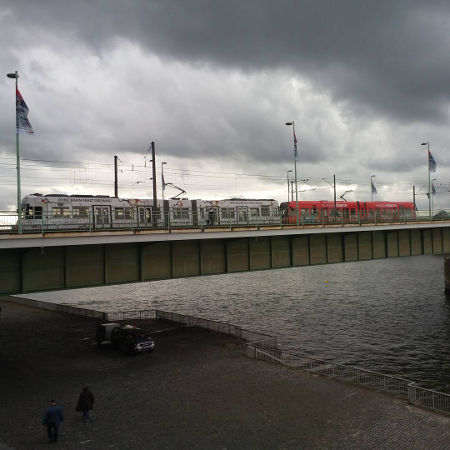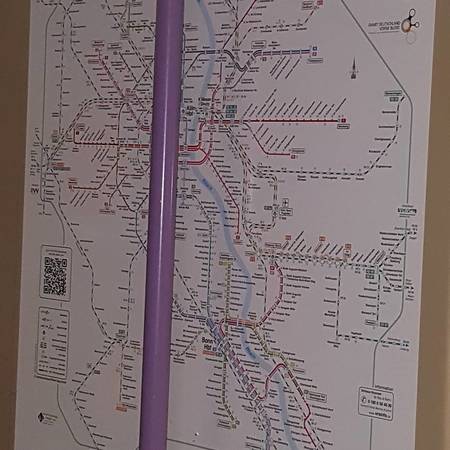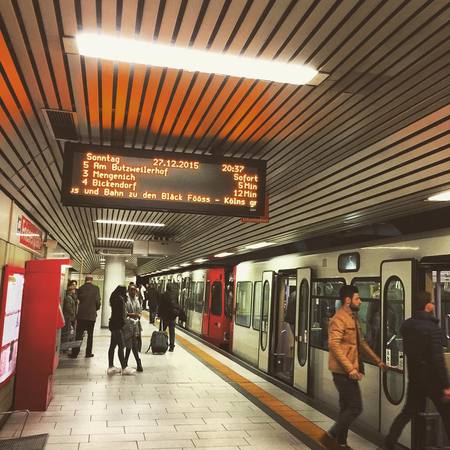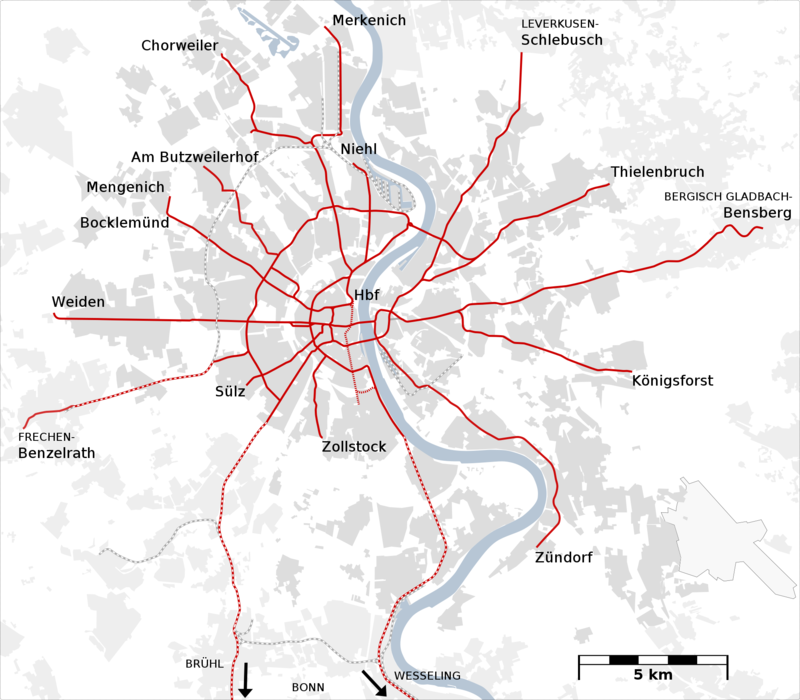The Cologne Metro is an underground transportation system found in the west of Germany in the city of Cologne. The metro is also known as the Stadtbahn, which is German for light rail. Its 194.8 kilometers (121 miles) are distributed along 12 lines and 223 stations. 38 of these are underground.
The Cologne Stadtbahn was inaugurated on October 11, 1968, and has experienced more than a hundred modifications, including line expansions and the construction of new stations. The system operates in conjunction with the tram and the S-Bahn, a train that operates in the city’s surrounding areas. The system’s standard fare is 1.90 euros ($US 2.30) and it operates from 5:00 am to 12:00 midnight.
Metros in Germany: Cologne
Cologne is a metropolis located in the western part of Germany, right next to the banks of the Rhine River. Bringing together 1,081,701 people, Cologne is the most densely populated city in the federated state of North Rhine-Westphalia. It is also the third largest city in the Federal Republic of Germany, covering a total surface area of 405.15 square kilometers (251.7 square miles). Only Berlin, Hamburg and Munich surpass this land expanse.
Cologne is a major economic and financial center in Germany, however, the true value in making this cultural capital home is in everything that it brings together. Converging among its streets is an exuberant harmony of modern architecture and century old buildings such as the Cologne cathedral, built in 1248. Cologne’s climate is halfway between oceanic and continental. The city’s temperature ranges between 14 and 19°C (57.2 and 66.2°F) during the hotter months, and the average temperature during winter months is between 3 and -0.5°C (37.4 and 31.1°F).
The Cologne Metro travels 194.8 kilometers (121 miles) around the city’s four compass points and its surrounding areas. Its inauguration took place on October 11, 1968 with the implementation of a route running from Friesenplatz to Dom/Hauptbahnhof station. New stations were added as the years passed, transforming the region into an integrated system.
Almost the entire fleet is currently integrated with Flexity Swift K4500 trains, although the modern K5000 and K5200 models have recently been incorporated. These light rail vehicles were manufactured by the German Canadian company, Bombardier Transportation which is characterized by its low-floor models. They operate as two cars. Technically, they can operate with up to four but the stations typically just have space for two.
 Cologne Stadtbahn
Cologne Stadtbahn
Approximately, 493,150 passengers use the metro daily. The region’s entire transportation system is run by Kölner Verkehrs-Betriebe AG (KVB), which is Cologne’s Public Transport Association.
- Known as: KVB or Stadtbahn
- Length: 194.8 kilometers (121 miles)
- Rail width: 1,435 mm (4.7 ft)
- Number of lines: 12
- Number of stations: 233
- Maximum speed: 72 km/h (44.7m/h)
- Website: www.kvb.koeln
- Operator: Cologne Public Transport Association (Kölner Verkehrs-Betriebe AG, KVB)
- Daily ridership: 493,150
- Founded: October 11, 1968
Brief history
Following the Second World War, reconstruction began on all the railways affected by the military conflict. This gave rise to the elaboration of a complete transportation development plan that proposed the extension and improvement of the surface level railway as well as the construction of new lines. These lines included the first stretch of underground tunnels, a structural idea that was finally realized in 1956, when construction work began.
Though the project began to take shape as a reproduction of surface level trams on the underground lines and officially qualified as a predecessor to the metro, it had always been perceived as a heavy rail in Cologne’s collective imagination. The first underground tunnel route was ready in 1963 and traveled through the entire city center, from Magnusstraße to Dom /Hauptbahnhof station.
The official inauguration took place on October 11, 1968, when the first operating phase was put into place. It underwent its initial expansions in 1970, when all the tram lines were interconnected to the main underground system that ran from one end of central Cologne to the other. Since then, the entire city and part of its neighboring areas have been joined together by the railway transportation’s major connection point.

Lines and stations
The Cologne metro, also known as KVB or Stadtbahn, is made up of 12 lines that supply service to 233 stations. They are divided among 195 surface level tram stops and 38 metro stops. All of them operate under the administration of KVB, the Cologne Public Transport Association. Some of the stations that merge at some point along the route or make parallel trajectories share the same distinct color.
Line 1
This route crosses the city from east to west. It runs from Weiden West station to Bensberg station, covering a total of 26.5 kilometers (16.5 miles). It consists of 14 stations, of which the first 8 connect to the surface level tram and the other 6 connect to the underground ones. This line is distinguished by the color red.
Line 3
Line 3 runs along the city’s east-west corridor. However, certain routes travel north to south. It provides service over a course of 21.5 kilometers (13.4 miles), a distance among which 17 stations are divided. 10 of these stations connect underground and three connect to the tram. They run from Mengenich station to Thielenbruch station. Pink is this line’s distinguishing color.
Line 4
Line 4’s route runs along the west-east corridor from Bocklemünd to Schlebusch station. There are a total of 17 stations of which 12 are a part of the underground system and the rest are tram stops. Its route is 21.7 kilometers (13.5 miles) and as it runs parallel to Line 3, its distinctive color is pink.
Line 5
This line runs diagonally across the city’s north-south corridor. It extends a total of 12.3 kilometers (7.6 miles) and includes six stations. Almost every line is integrated with the main part of the underground system. The stretch belonging to the tram interconnects with Line 13 and its underground portion connects to Line 3. It runs from Am Butzweilerhof station to Haymarket station and is identified by the color purple.
Line 7
Initially, this route runs along the east-west corridor. However, near the end of the route, it begins running north to south. The entire trip is a total of 25.8 kilometers (16 miles), among which neighboring areas of the city can be found. The metro’s Line 7 runs from Frechen to Zündorf station. There are a total of 12 stations, all of which make up the surface level tram. This line can be identified by the color orange.

Line 9
This line runs along the east-west corridor, from Sülz to Königsforst station. Its complete route is 16 kilometers (10 miles) and it connects to a total of 15 stations of which six belong to the underground system. The rest belong to the surface level tram. It runs parallel to Line 1 up to its connection at Heumarkt station where it begins to run underground. Light pink is this line’s distinguishing color.
Line 12
Running from Merkenich station to Zollstock station, this route covers the north-south corridor of the city. Its route is a total of 17 kilometers (10.6 miles) on which 15 stations are distributed. Nine of these are a part of the underground system and 6 are on the surface level tram. As it crosses from one side of the city to the other, it connects to all the system lines at certain points. This line’s distinguishing color is green.
Line 13
From one end of the city to the other, this route extends 16.2 kilometers (10.1 miles), in the shape of a half moon. A total of 21 stations are integrated along this line, eight which are underground, while the rest are a part of the surface level tram. It connects with lines 18 and 16 of the tram, the first being south of Cologne while the second is north. Brown is this line’s distinguishing color.
Line 15
This line runs from Chorweiler station to Ubierring station and covers a route of 15.2 kilometers (9.4 miles). Line 12 connects at Zulpicher Platz station, from which the route begins to run through the underground tunnels until reaching the northern end of the city. Line 15 includes a total of 13 stations, of which 7 are a part of the underground system. As this line runs parallel to Line 3, its distinguishing color is also green.
Line 16
This line runs along the city’s north-south corridor and connects to Line 18 as it travels through the city center. It has a length of 45.6 kilometers (28.3 miles), which mostly consists of the stretch along the city’s neighboring areas. There are a total of 16 stations that run from Niehl Sebastainstr station to Bonn-Bad Godesberg station. Most are a part of the surface level trams. The distinguishing color for this line is blue.
Line 17
Line 17 is the shortest line in the system. It is only 8.5 kilometers (5.3 miles) along which the underground stations, Severinstr, Chlodwigplatz and Rodenkirchen are distributed. It runs along the north-south corridor of the city and a pedestrian tunnel connects it to Line 5. Light blue is Line 17’s distinguishing color.
Line 18
This is Cologne’s longest railway line. It extends a total of 48.4 kilometers (30 miles) of which 30 of its stations are located on the outskirts of the city. Its path runs specifically along the north-south corridor and midway through the route, it connects with Line 16. It is made up of 18 stations that run from Thielenbruch to Hauptbahnhof in Bonn. Eight of the stations can be found in the underground tunnels, while the rest are located on the surface level of the city. Running parallel to Line 16, its distinctive color is blue.
 Dorint Hotel am Heumarkt
Dorint Hotel am Heumarkt
Connections with other systems
Cologne’s transportation system is completely interconnected. There are sections on every line that connect with the underground train and others that connect with the surface level tram. The train system has connections to the bus line which is also a part of the KVB. The bus network has a total of 48 lines that travel from one end of the city to the other and most have stops around Stadtbahn’s main stations.
The S-Bahn is the main transportation system to integrate with the metro, as it is a commuter train that connects Cologne to neighboring towns. This is actually the southern part of the Rhine-Ruhr region’s S-Bahn system. There are six lines and 65 stations that connect to the Stadtbahn at various points.
In addition to the railway system and the bus line, the city’s public transportation system manages Kolner Seilbahn. This is essentially a cable car that crosses the Rhine River to connect the far ends of the city. This transportation system is wired to connect with Line 18 of the metro and Line 140 of the bus system. However, the cable car is currently out of service due to an accident on July 30, 2017 and the system has remained under inspection over these last few months.
The KVB devised another option for traveling throughout the city center. Inaugurated in 2015 and christened KVB-Rad, this is a program developed in partnership with the German company, Nextbike. This includes a large bicycle rental stop installation located in the city’s historic center. Thousands of bikes are available for cycling throughout the entire service area for a selected time.
Connections to the airport
The Cologne-Bonn Konrad Adenauer International Airport is Germany’s sixth most important air terminal. It is located 15 kilometers (9.3 miles) from central Cologne and 16 kilometers (10 miles) from Bonn, a satellite city located northeast of the metropolis. In addition to this characteristic, this is the busiest terminal area in the country, deeming it worthy of having its own bus and train stations.
In 2004, the Bahnhof Köln/Bonn Flughafen, the airport train station was inaugurated. Traveling via Intercity Express (ICE) ICE 10, ICE 45 and ICE 49 routes, the station provides a connection to Köln Hauptbahnhof, which in turn, connects with lines 16 and 18 of the metro. The airport station also connects with the regional train lines RE6 and RE8 and the S-Bahn S13 line, which also connects at Köln Hauptbahnhof.
A bus station, which connects to the main underground stations and the municipal tram, is also available at this airport.
Schedule and frequency
The Cologne Metro has an operating schedule that runs on average from 5:00 am until midnight. All the lines run in similar intervals at similar times. However there are particular variations on each one. It is important to note that on Fridays and Saturdays, the system provides continuous service with the exception of Line 13 which runs just part of the night. Similarly, frequency can vary considerably, depending on the line, day and time. It is best to consult Cologne Stadtbahn’s updated schedules on the official website, which is available in several languages, at https://www.kvb.koeln/.
 Innenstadt
Innenstadt
Fees, tickets and cards
Like all Europe’s large transportation systems, Cologne’s railway system has an extensive variety of fees and payment forms for its services. The ticket prices vary according to the trips taken, the geographic area and the station routes. All regulations are established by the KVB, along with the other systems that offer them. It is important to note that the prices for train system tickets are different from the bus ticket prices, even though they operate under the same management.
K Ticket: This is a short distance ticket that can be used for up to four station stops on the railway. There are no restrictions within the city limits but it cannot be used on the express regional trains and some bus lines.
1A Ticket (CityTicket): This ticket is for trips within a city but not in Cologne and Bonn. It allows single trips between towns like Frechen, Leverkusen, Siegburg and Euskirchen.
1B Ticket (CityTicket): This can be applied to single trips for up to a maximum of four stations within the cities of Cologne or Bonn and is valid on any of the network’s modes of transportation.
2A Ticket (CityPlus): This ticket includes trips to cities or neighboring municipalities that are outside of Cologne or Bonn. With this ticket, transportation is permitted to counties such as Erftstadt, Kerpen, Rösrath and Lohmar.
2B Ticket (City Plus): This ticket is valid for trips from Cologne or Bonn to other cities or neighboring municipalities and vice versa. Travel is available to cities such as Berg, Gladbach and Bornheim.
MobilPass: This is a special VRS network card that can be purchased at the city’s various authorized JobCenter locations. The MobilPass offers discounts on every KVB ticket type and rate zones. The following table shows all ticket types and their various pricing.
 Cologne Stadtbahn Fares
Cologne Stadtbahn Fares
However, general ticket prices have undergone modifications according to various programs offered by the KVB. Fee variations are distinguished according to the occupation, age and the academic level of the rider.
Among the transportation association’s proposed offers is the PrimaTicket. Designed for primary students, it can only be used on direct routes between home and school and is valid from Monday to Friday, from 5:00 am to 6:00 pm. The responsibility of the ticket cost is usually assumed by the academic institution and can be paid in eleven monthly installments.
Another program is the Schüler Ticket, which is especially designed for secondary students. This is a smart card that is valid for 365 days of the year and throughout the entire service schedule. It cost 10 euros (12.2 US$) and cannot be used by people over the age of 16.
Additionally, there is the Alumini Ticket which is especially for alumni, under the age of 21. It is only valid from January 1 to September 30 and may only be used between 9:00 am and 3:00 pm. As of 2018, the Alumini Ticket can be purchased for 97.50 euros (119.19 US$) and includes unlimited trips within the city and its surroundings. Among other KVB options, is the purchase of a Bahncard 100, which allows holders free travel through the region and local surrounding areas. This can be done on any of KVB’s modes of transportation and the only condition is that the departure and destination be specified. In this case, it is Cologne.
The KVB also offers various subscription methods for frequent travelers that include weekly, monthly or annual payments. It is important to note Cologne’s transportation system has various purchase options. Purchases can be made online, from machine dispensers located along city streets, from ticket offices at particular stations or through the HandyTicket app. A 3% discount on all methods is offered with the app.
 Innenstadt
Innenstadt
Future expansions
Among the development plans proposed by the KVB, particularly on the railway system, is the construction of a tunnel that is 3.9 kilometers (2.4 miles) long and that will cross through the system’s underground lines 5 and 16. This will go from Breslauer Platz station, on Line 18, to Bonntor. Additionally, the system has a proposal to extend Line 3 to the west of the city that will reach Görlinger Zentrum through the underground tunnels. The public transportation association expects to complete both works in the current decade.
Tips
Despite Cologne’s low criminal index, it never hurts to take certain security precautions while also protecting ones belongings. While in system facilities, it is therefore recommended to keep all personal belongings close by and to remain cognizant of any actions that suggest a possible theft.
It is also recommended to consistently check one’s ticket validity to ensure that it is being used in the right location for which it was purchased. This is due to it not being necessary to go through turnstiles, but that there is a chance that an official may still ask to check the ticket.
The KVB offers an employee-managed service that provides advice related to the system’s ticket plans and particular routes. Consulting this personnel team is usually recommended, especially when touring.
Notable facts
- Although there is space designated for bicycles on each of Cologne’s transportation methods, it is up to the discretion of KVB employees to decide, at any particular time, whether or not bikes are permitted.
- Dogs travel, completely free of charge, on the railway network.
- Uniformed police from North Rhine-Westphalia and the Federal Border Guard can travel, ticket free, on any of KVB systems.
Sightseeing via Cologne Metro
Cologne is considered one of the most culturally developed cities in all of Germany. This perception is supported by the large number of museums, theaters, creative spaces and artistic recreation surrounding the city. Additionally, Cologne exhibits a magnificent synthesis between antique architecture and the monuments of the 21st century. Some places to visit, via the Stadtbahn, include:
- Museum Ludwig: This is one of the most breathtaking exhibitions of modern art in the country. It draws together the world’s second largest collection of pop art. Inaugurated in 1986, a large number of works by artists such as Pablo Picasso, Salvador Dalí and René Magritte can be found in its studios. The facility bears the name Ludwig due to the initial funding by the Cologne high-society couple as well as the endowment of 350 works of art. The museum can be reached from Hauptbahnhof station, on metro lines 16 and 18.
- Cologne Catedral: The cathedral is considered one of the most important works of gothic architecture and one of the oldest religious references in the city. Its origins are founded in the medieval era and it remains witness to millions of pilgrimages. Its treasured artistic capital and the heirlooms that it preserves have resulted in the area being declared a World Heritage Site. The Cologne Cathedral can be reached by taking Line 16 or 18 to Hauptbahnhof station and walking a few blocks.
- University of Cologne: A favorite place for tourists to visit in this German city is the University of Cologne’s campus. The institution is set as one of the most prestigious universities in the country and world. In addition to its scholarly brilliance, it is an ideal place to enjoy nature and architectural majesty. The university can be reached by taking Line 9 to Hochschule station.
Cologne Stadtbahn map
- Also Known As: Stadtbahn
- Passengers/Day
- Fares: honour system
- 24h operation: No
- Air Conditioning: New light rail trains only
- Walk between platforms: Yes
- Driverless trains: No
- Screen Doors Platforms: No
- Operator: Kölner Verkehrs-Betriebe (KVB)
- 1
- Cologne Metro Official Website
- Tlf: +49 0221 5 47 0
Help us
If you consider that the information we provide is wrong, not accurated, outdated, translation contains errors, and you would like to help us to improve the file...you can contact us here.
Feel free to contact us if you dont find the system you're looking for and we'll add it as soon as we can!
Thank you very much!










